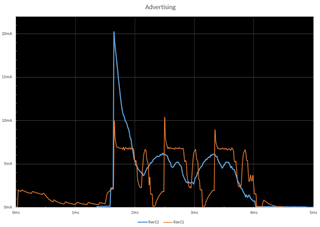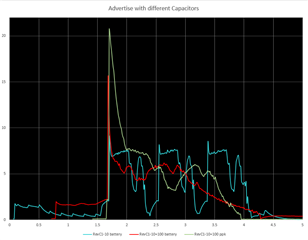I was wondering if adding a capacitor in parallel with the coin cell battery would help with the battery life by smoothing out the peaks. The scenario shown in the chart is a BLE advertising event (every 1s). I first added a 10uF then also a 100uF capacitor in parallel and took a trace of the power profile. The two series shown is with a 10uF capacitor (orange line) and the other series with both 10uF+100uF capacitors (blue line). Looking at the charts, I have two questions:
1. For the 100uF series, why is there a large spike at the start of the advertising event ? I expected the larger capacitor to help smooth out the initial peak of the advertising event not make it worse. (there's a bit of CPU work before the main spike which is smoothed out but that should not deplete the capacitor). Instead, it looks like its charging at the same time and I suspect there needs to be some way to limit the draw of the capacitor. I tried adding in various resistors but that just converges to not having a capacitor in the first place.
2. It does not look like adding in the 100uF is helping at all, are there ways to make it help and not hurt or is it better to not have it ?

Update:
I am using the ppk with an external board thats using an nrf52832. The cap is 100µF ±20% 6.3V Ceramic Capacitor X5R 1210 (Kemet Part #: C1210C107M9PACTU). I re ran the tests using the power select from the ppk (reg) and also using an external supply (cr2450). I noticed some differences between using these two power sources (see chart below). The total charge used between using a cap and not using one seems to be about the same. I have aligned the charts manually so I cant say for sure what the exact alignment is between the scenarios but the added spike is still intriguing but somewhat less when using the battery power source. I had previously read the links provided in the responses below.

Update 2:
I re ran the tests. For the first results I reported above I used the python version of the ppk UI, and now I tried the new desktop version and got very different results, much more inline with what one would intuitively think about it. So, by adding in the battery as the external supply and the new UI is what gave me intuitive results. I'm going to run it again on a power analyzer to make a final check :-)


